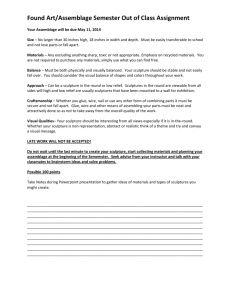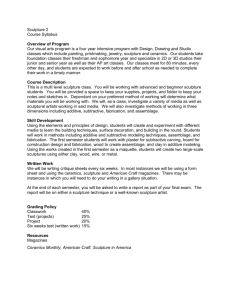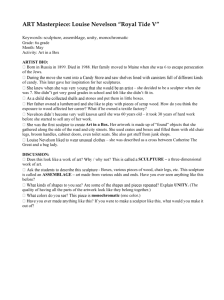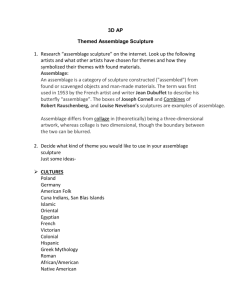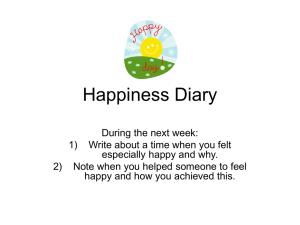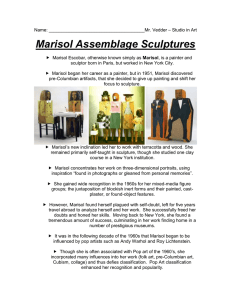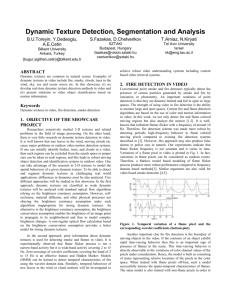Marisol/Thinking outside the box
advertisement
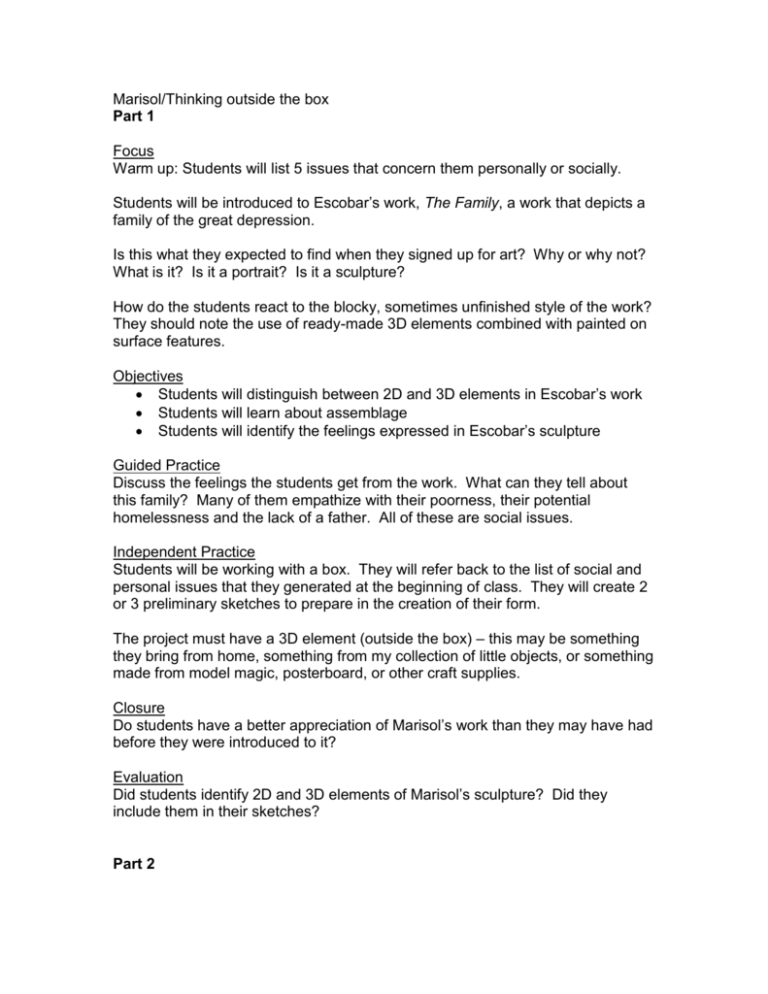
Marisol/Thinking outside the box Part 1 Focus Warm up: Students will list 5 issues that concern them personally or socially. Students will be introduced to Escobar’s work, The Family, a work that depicts a family of the great depression. Is this what they expected to find when they signed up for art? Why or why not? What is it? Is it a portrait? Is it a sculpture? How do the students react to the blocky, sometimes unfinished style of the work? They should note the use of ready-made 3D elements combined with painted on surface features. Objectives Students will distinguish between 2D and 3D elements in Escobar’s work Students will learn about assemblage Students will identify the feelings expressed in Escobar’s sculpture Guided Practice Discuss the feelings the students get from the work. What can they tell about this family? Many of them empathize with their poorness, their potential homelessness and the lack of a father. All of these are social issues. Independent Practice Students will be working with a box. They will refer back to the list of social and personal issues that they generated at the beginning of class. They will create 2 or 3 preliminary sketches to prepare in the creation of their form. The project must have a 3D element (outside the box) – this may be something they bring from home, something from my collection of little objects, or something made from model magic, posterboard, or other craft supplies. Closure Do students have a better appreciation of Marisol’s work than they may have had before they were introduced to it? Evaluation Did students identify 2D and 3D elements of Marisol’s sculpture? Did they include them in their sketches? Part 2 Focus Students will compare and contrast The Family and Women Shopping. Objectives Students will determine what is similar and different in the content of these works Students will look for similarities in Marisol’s portrayals of people Students will learn about actual and implied textures Guided Practice A consistent element in Escobar’s sculpture is the use of texture. It is found in her choice of materials, but is often created by her. Students will be shown how to create rubbings of texture using crayon on construction paper. Their work must include at least 3 textures, and must have one implied and one actual texture. Independent Practice Students will generate 10 textures during this class period. Some can be rubbings, some can be drawn using other methods. Not all of them have to be used on the project. Closure Where do we find texture? Students may also bring things to include as part of their assemblage that are textures. Evaluation Did students recognize that textures are found all around them? Did they notice the textures of the ceiling? The brick? Their shoes? Did they create a variety of textures? Did they try different techniques for creating textures? Part 3 Focus Warm up: define assemblage Objectives Students will learn about the sculptural technique of assemblage Students will combine 2D and 3D parts to create an assemblage Students will learn about additive and subtractive sculpture Guided Practice Instructor will demonstrate techniques for gluing or affixing 2D and 3D pieces onto box. They will learn how to use hot glue, white glue, and wire to affix objects to box. They will also learn how to cut holes and slots into boxes using an exacto blade so a variety of methods can be used in the creation of their box. Students have had a safety form signed at the beginning of the course. ReEmphasize the necessity of safety and responsibility! Independent Practice Students’ projects will vary significantly depending on the variety of social issues. Stations will be used to allow for differing levels of progress and material needs. Students should be applying textures and objects to their boxes. Closure Show examples of sculpture. Define and discuss additive and subtractive processes. Are assemblages additive or subtractive? Evaluation Did students work productively at the stations? Did they use appropriate materials to adhere or fix 2D/3D pieces to their boxes? Part 4 Focus Students will read a Mel Chin article in small groups. They will consider and discuss reasons it is considered “science” and reasons it is considered “art.” Record responses using Venn diagram What areas overlap???? They will then see streaming video of his interview on Art21. Objectives Continue learning about art that addresses social issues Write a poem or free verse that will be used as text on their assemblage to help convey the meaning behind their project Guided Practice Did any of the students participate in the poetry open-mike? Students will walk through thought processes of creating poem with in progress teacher’s model. Independent Practice Students will independently create a poem that they will use on their sculpture. They will write the verse on paper that will be affixed to their work. They should consider placement their decision making process. Recall patriotic project – Erin’s song lyrics on eagle’s head, Robert’s 5o states in the white stripes Closure Invite students to share their writing and discuss how it contributes to the meaning of their project. Will students ever look at a box the same again? How many of them have heard of “thinking outside the box?” Evaluation Did students write poetry that related to their social issue? Did they write their poem in a create manner – ie. In the box? Around the edge?

